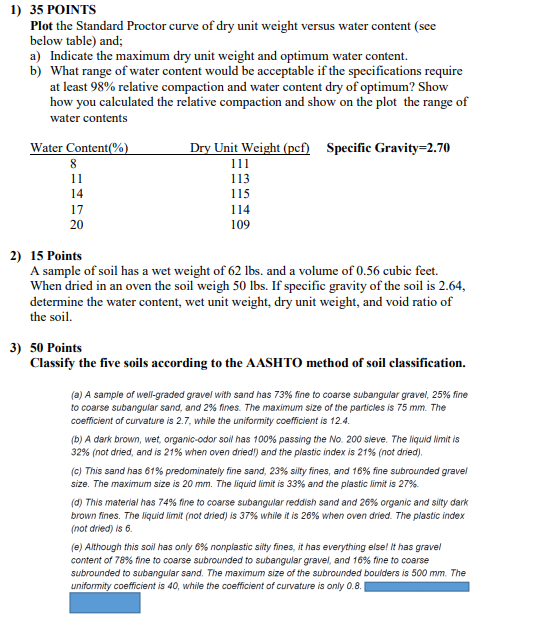Plot the Standard Proctor curve of dry unit weight versus water content (see below table) and; a) Indicate the maximum dry unit weight and optimum water content. b) What range of water content would be acceptable if the specifications require at least 98% relative compaction and water content dry of optimum? Show how you calculated the relative compaction and show on the plot the range of water contents Water Content(%) Dry Unit Weight (pcf) Specific Gravity=2.70 8 11 14 113 115 17 20 114 109
Plot the Standard Proctor curve of dry unit weight versus water content (see below table) and; a) Indicate the maximum dry unit weight and optimum water content. b) What range of water content would be acceptable if the specifications require at least 98% relative compaction and water content dry of optimum? Show how you calculated the relative compaction and show on the plot the range of water contents Water Content(%) Dry Unit Weight (pcf) Specific Gravity=2.70 8 11 14 113 115 17 20 114 109
Principles of Geotechnical Engineering (MindTap Course List)
9th Edition
ISBN:9781305970939
Author:Braja M. Das, Khaled Sobhan
Publisher:Braja M. Das, Khaled Sobhan
Chapter2: Origin Of Soil And Grain Size
Section: Chapter Questions
Problem 2.2CTP: Refer to Problem 2.C.1. Results of the sieve analysis for Soils A, B, and C are given below. To...
Related questions
Question

Transcribed Image Text:1) 35 POINTS
Plot the Standard Proctor curve of dry unit weight versus water content (see
below table) and;
a) Indicate the maximum dry unit weight and optimum water content.
b) What range of water content would be acceptable if the specifications require
at least 98% relative compaction and water content dry of optimum? Show
how you calculated the relative compaction and show on the plot the range of
water contents
Water Content(%)
Dry Unit Weight (pcf) Specific Gravity=2.70
8
111
11
113
115
114
14
17
20
109
2) 15 Points
A sample of soil has a wet weight of 62 lbs. and a volume of 0.56 cubic feet.
When dried in an oven the soil weigh 50 lbs. If specific gravity of the soil is 2.64,
determine the water content, wet unit weight, dry unit weight, and void ratio of
the soil.
3) 50 Points
Classify the five soils according to the AASHTO method of soil classification.
(a) A sampie of well-graded gravel with sand has 73% fine to coarse subangular gravel, 25% fine
to coarse subangular sand, and 2% fines. The maximum size of the particles is 75 mm. The
coefficient of curvature is 2.7, while the uniformity coefficient is 12.4.
(b) A dark brown, wet, organic-odor soil has 100% passing the No. 200 sieve. The liquid Nmit is
32% (not dried, and is 21% when oven dried!) and the plastic index is 21% (not dried).
(c) This sand has 61% predominately fine sand, 23% silty fines, and 16% fine subrounded gravel
size. The maximum size is 20 mm. The liquid limit is 33% and the plastic limit is 27%.
(d) This material has 74% fine to coarse subangular reddish sand and 26% organic and silty dark
brown fines. The liquid limit (not dried) is 37% while it is 26% when oven dried. The plastic index
(not dried) is 6.
(e) Although this soil has only 6% nonplastic sity fines, it has everything else! It has gravel
content of 78% fine to coarse subrounded to subangular gravel, and 16% fine to coarse
subrounded to subangular sand. The maximum size of the subrounded boulders is 500 mm. The
uniformity coefficient is 40, while the coefficient of curvature is only 0.8.
Expert Solution
This question has been solved!
Explore an expertly crafted, step-by-step solution for a thorough understanding of key concepts.
This is a popular solution!
Trending now
This is a popular solution!
Step by step
Solved in 2 steps with 2 images

Knowledge Booster
Learn more about
Need a deep-dive on the concept behind this application? Look no further. Learn more about this topic, civil-engineering and related others by exploring similar questions and additional content below.Recommended textbooks for you

Principles of Geotechnical Engineering (MindTap C…
Civil Engineering
ISBN:
9781305970939
Author:
Braja M. Das, Khaled Sobhan
Publisher:
Cengage Learning

Fundamentals of Geotechnical Engineering (MindTap…
Civil Engineering
ISBN:
9781305635180
Author:
Braja M. Das, Nagaratnam Sivakugan
Publisher:
Cengage Learning

Principles of Geotechnical Engineering (MindTap C…
Civil Engineering
ISBN:
9781305970939
Author:
Braja M. Das, Khaled Sobhan
Publisher:
Cengage Learning

Fundamentals of Geotechnical Engineering (MindTap…
Civil Engineering
ISBN:
9781305635180
Author:
Braja M. Das, Nagaratnam Sivakugan
Publisher:
Cengage Learning